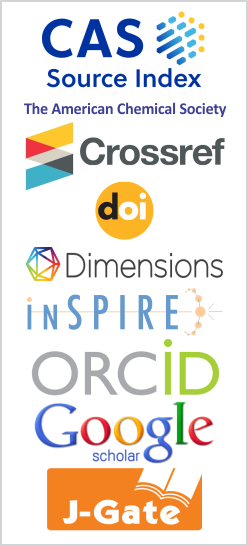OSL Dosimetry Using LiCaAlF
DOI:
https://doi.org/10.26713/jamcnp.v9i1.1960Keywords:
LiCaAlFAbstract
LiCaAlF
Downloads
References
Abhishek, A. Sahare, S. Sahare, M. Singh, P.D. Sahare, Luminescence characteristics of LiCaAlF6:Eu TLD phosphor, Journal of Atomic, Molecular, Condensed Matter and Nano Physic 9(1) (2022), 85 – 92, DOI: 10.26713/jamcnp.v9i1.1964.
J. Azorín, C. Furetta and A. Scacco, Preparation and properties of thermoluminescent materials, Physica Status Solidi (a) 138(1) (1993), 9 – 46, DOI: 10.1002/pssa.2211380102.
B.C. Bhatta and M.S. Kulkarni, Thermoluminescent phosphors for radiation dosimetry, Defect and Diffusion Forum 347 (2014), 179 – 227, DOI: 10.4028/www.scientific.net/DDF.347.179.
L. Bøtter-Jensen, S.W.S. McKeever and A.G. Wintle, Optically Stimulated Luminescence Dosimetry, Elsevier Science Inc. (2003), DOI: 10.1016/B978-0-444-50684-9.X5077-6.
S.W.S. McKeever, Thermoluminescence of Solids, Cambridge University Press (1985), DOI: 10.1017/CBO9780511564994.
G. Rani and P.D. Sahare, Effect of phase transitions on thermoluminescence characteristics of nanocrystalline alumina, Nuclear Instruments and Methods in Physics Research Section B: Beam Interactions with Materials and Atoms 311 (2013), 71 – 77, DOI: 10.1016/j.nimb.2013.06.018.
P.D. Sahare, J.S. Bakare, S.D. Dhole and P. Kumar, Effect of phase transition and particle size on thermoluminescence characteristics of nanocrystalline K2Ca2(SO4)3:Cu+ phosphor, Radiation Measurements 47(11-12) (2012), 1083 – 1091, DOI: 10.1016/j.radmeas.2012.10.003.
P.D. Sahare, M. Singh and P. Kumar, Effect of annealing and impurity concentration on the TL characteristics of nanocrystalline Mn-doped CaF2, Radiation Measurements 80 (2015), 29 – 37, DOI: 10.1016/j.radmeas.2015.07.003.
M. Singh and P.D. Sahare, Redox reactions in Cu-activated nanocrystalline LiF TLD phosphor, Nuclear Instruments and Methods in Physics Research Section B: Beam Interactions with Materials and Atoms 289 (2012), 59 – 67, DOI: 10.1016/j.nimb.2012.08.003.
E.G. Yukihara and S.W.S. McKeever, Optically Stimulated Luminescence: Fundamentals and Applications, John Wiley & Sons, Ltd. (2011), DOI: 10.1002/9780470977064.
Downloads
Published
How to Cite
Issue
Section
License
Authors who publish with this journal agree to the following terms:- Authors retain copyright and grant the journal right of first publication with the work simultaneously licensed under a CCAL that allows others to share the work with an acknowledgement of the work's authorship and initial publication in this journal.
- Authors are able to enter into separate, additional contractual arrangements for the non-exclusive distribution of the journal's published version of the work (e.g., post it to an institutional repository or publish it in a book), with an acknowledgement of its initial publication in this journal.
- Authors are permitted and encouraged to post their work online (e.g., in institutional repositories or on their website) prior to and during the submission process, as it can lead to productive exchanges, as well as earlier and greater citation of published work.




